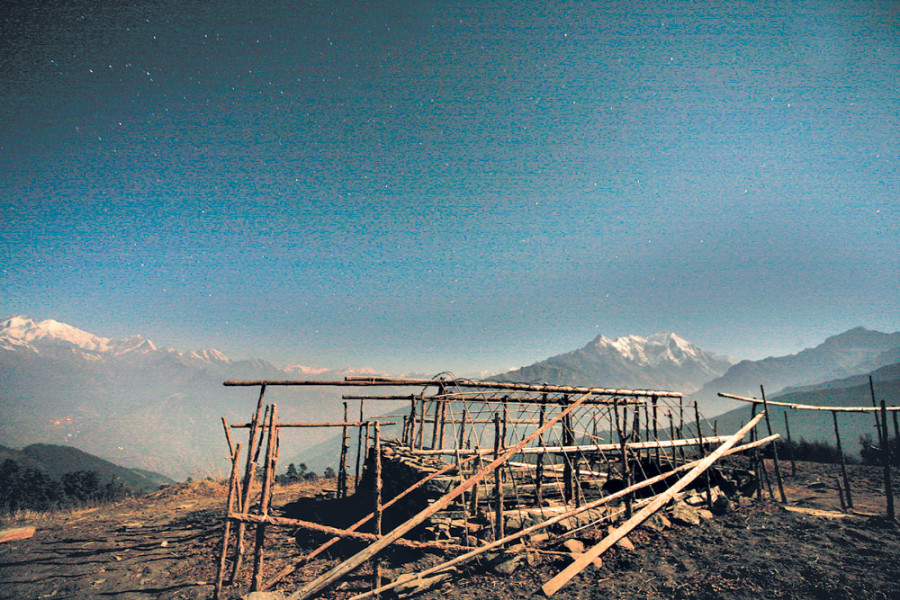Miscellaneous
Rasuwa by night
Outside the calm chaos of Kathmandu, merely 130 km away, is Gosainkunda—pleasant during the day, absolutely enchanting by night
Thomas Mattey
The spiritual presence and natural phenomenon that is the Langtang National Park has always been something I have wanted to see with my own eyes. After a month of planning the build of a renewal centre in Pulchowk and the application close to submission, a friend and I felt we deserved to look outside the calm chaos of Kathmandu and take four days to explore Langtang. With little research, and even less equipment, we headed by motorbike 120 km away to Dunche, Rasuwa, the starting point for the ancient pilgrimage that takes you to Gosainkunda. The well-trodden path takes you through ancient forests, over waterfalls, past round winding mountain tracks and between snow covered tops of the Langtang mountain range. Our destination was the lakes at 4,500 m, where we planned, like thousands each year, to show gratitude to Shiva.

The road from Kathmandu is winding and rugged. Evidence of post-earthquake trauma is everywhere—in the constant redevelopment of the roads and houses. We stopped for our first night in Bidur and were welcomed by Dinesh—a young boy orphaned by last April’s disaster, who is now staying with his uncle and aunt. We were welcomed with the genuine warmth that I have felt from all Nepalis, and if it wasn’t for a tremor in the night, you’d be forgiven for forgetting how devastated Rasuwa was by the disaster.

We drove the winding road to Dunche at 7am, finally shedding the city and breathing the fresh mountain air. Warm smiles greeted us everywhere. On arrival in Dunche, we stocked up on supplies and asked locals for advice on the trek—all of whom thought our time frame was a bit ambitious but not impossible—and then slept well until more tremors woke us at 3am. We began the pilgrimage at 5:30am. The first part of the trek passed rivers and waterfalls. The steep steps through the forest tested our stamina and city-beaten lungs. As the sun began to rise we stopped for breakfast and were told that there had been far less trekkers and tourists since April 2015. In an area that is heavily reliant on tourism, we were happy to be there and wished our ever smiling welcomers prosperity.

The winding steps took us to Sing Gompa (3,270m). We had a nutritious lunch and walked higher along a less steep trail, through an enchanting pine forest reaching Cholong Pati (3,600m) by evening. We were tired but excited to be out of the forest and able to view the spectacular views of the dusk-painted Langtang mountain range to our left and Tibet to our right. I took a short walk to a nearby peak as the full moon came up and lit the mountains like daylight. If the photographs I took captured a fraction of the beauty of that night then I would commend myself for a job done well.

Partly inspired by our construction meeting in Kathmandu in two days and partly by the bright moonlight, we started the last part of the pilgrimage at 3am in all zest. Our eyes adjusted to the moonlight quickly and we climbed the final 900m in the night. We stopped for a breakfast of champions: two bananas, half a jar peanut butter, an orange and a quarter of whisky. The final 370m were the hardest. Bitten by the cold and feeling the air getting thinner, we were beginning to get very tired.

The path takes round a steep pass with long drops. We waited in the cold until the sunrise hit us; the warm rays helping us complete the final steps to Gosainkunda (4,370m). The frozen lakes welcomed us with an orchestra of groans and cracks and the sun that preceded us thawed the lake; the chanting of cracking and shifting engulfing the quiet. We were the only two people there and we basked in the sun, walked on the frozen lake, paid our respects to Shiva at the temple and took a nap for a couple of hours in the peaceful vicinity.

The trek down was quick and exciting. As the sun hit the path, the Pyrite-rich sand glistened and sparkled—yet another ingredient that added to the magic of Gosaikunda. The familiar path got easier as we plummeted in altitude. After twisting my knee and using my camera tripod as a walking stick, we reached Dunche as evening broke. Feeling exhausted, sore, accomplished and overwhelmed by the atmosphere of Gosaikunda, sleep was the best option. The drive back to Kathmandu was quick. We hobbled into our construction meeting at 5pm on Tuesday after a life changing four days.

Now, I write this diary in an attempt to inspire others to make the worthwhile trip to Langtang and experience the humbling nature that Nepal has in abundance. It was a weekend I will never forget.





 7.12°C Kathmandu
7.12°C Kathmandu










